Hemoglobin is the special molecule that is responsible for carrying oxygen to other cells. Hemoglobin takes up oxygen in the lungs, leaves off carbon dioxide there, then moves onto the muscles. Meanwhile, the muscle cells have burned nutrients and produced carbon dioxide. When hemoglobin reaches the muscles, it does the opposite of what it first did in the lungs, depositing oxygen and picking up carbon dioxide.
Scientists think of hemoglobin as an extraordinary molecule because of these two different processes it carries out. In The Great Evolution Mystery, Gordon Rattray Taylor, an evolutionist himself, has written the following about hemoglobin:
… It is a remarkable molecule indeed which at one moment has an affinity for oxygen and a few seconds later loses that affinity; that it simultaneously changes its preferences with respect to carbon dioxide makes it even more remarkable. (Gordon R. Taylor, The Great Evolution Mystery, Harper and Row Publishers, New York, p. 108)
As this shows, the hemoglobin molecule is seemingly conscious, making the necessary move at exactly the required time and place, never confusing oxygen with carbon dioxide.
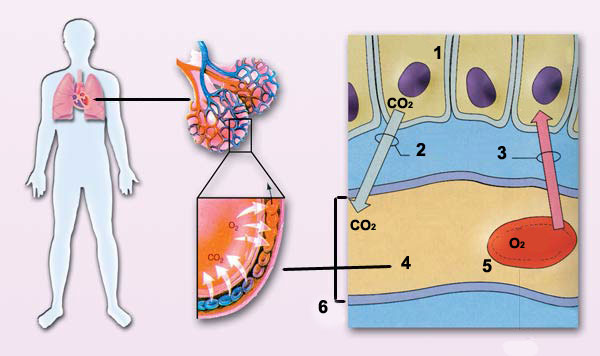 | ||
| Hemoglobin takes up oxygen from the lungs and leaves behind carbon dioxide. | ||
| 1.Tissue cells | 3. Taking up O2 | 5. Red blood cell |
This is obviously thought-provoking. How can a tiny molecule, which can't even be seen under a microscope, make decisions and have preferences?
As a result of the extraordinary consciousness displayed by this molecule, all air-breathing creatures on Earth can continue their existence with ease. About 900 million red blood cells are produced in the human body every hour. And there are about 300 million molecules of hemoglobin in one red blood cell alone. When you think about the total number of hemoglobin molecules in the body and the abilities that every single one of them possesses, you begin to comprehend more clearly the significance of all of this.
Every person of intellect must admit that such selectivity could never have arisen as a result of coincidence, and that coincidence could not have bestowed these characteristics upon billions of hemoglobin molecules. The Creator of hemoglobin with all its features, and the molecule's placement into the bodies of living things, is God.
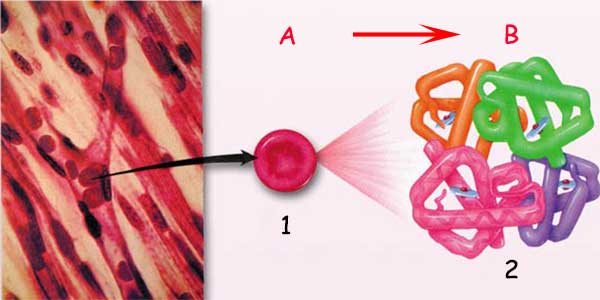 | |
| A. Just one red blood cell | 1.Red blood cell |
Many processes we are unaware of take place within our bodies. These processes are carried out by some 100 trillion cells, all performing their duties without fault, and without fail.
The many structures inside these cells know their duties very well. Some of them produce energy, others produce protein, some act as transporters, and others are used as storage depots.
One of the apparently conscious structures found in cells is the lysosome, which may be considered as the cell's digester. Many degradative processes can be carried out as a result of the enzymes these organelles contain. Aside from breaking down and destroying cells that are dead, diseased, or no longer useful, and puncturing and digesting the membrane that surrounds a structure, lysosome enzymes also destroy certain cells that are continuing to grow in the body. These breakdown processes carried out by the lysosome enzymes are of the utmost importance for health and ultimately, for survival.
For example, the womb of a pregnant woman develops at a much greater rate than normal to accommodate the development of her fetus—a necessary step for the birth of a healthy baby. Once the baby is born, however, no longer is there any need for such a spacious womb. Now this organ, which has increased so much, must return to its original size. The lysosome enzymes carry out this process. When labor is over, certain cells send this news to the lysosomes, which already know very well what they have to do and begin secreting the necessary enzymes. In ten days and at a very fast rate, these enzymes decrease the size of the womb by a factor of forty, returning it to its original size, for the health of the body.
Lysosomes are also found in the heads of sperm. A spermatozoal cell uses the lysosomes it carries to break through the membrane surrounding the egg it seeks to penetrate. Thus these enzymes' degradative properties facilitate the fertilization of the egg cell by breaking through its protective layer.
As these examples show, every mechanism in our bodies works in ways that complement every other. Just as one system allows the womb to grow during pregnancy, there is also a system to return it back to normal. In the same way, specially placed in the sperm is an enzyme with the ability to break through the egg's protective layer.
Darwinists have strayed so far from logic and reason as to claim that this perfect integrated system, which continues to proceed in a flawless fashion, is only the result of certain coincidences. The most perfect workings within these mechanisms, and their harmonious and systematic workings with the whole body, display the perfection of God's creation for everyone to see.
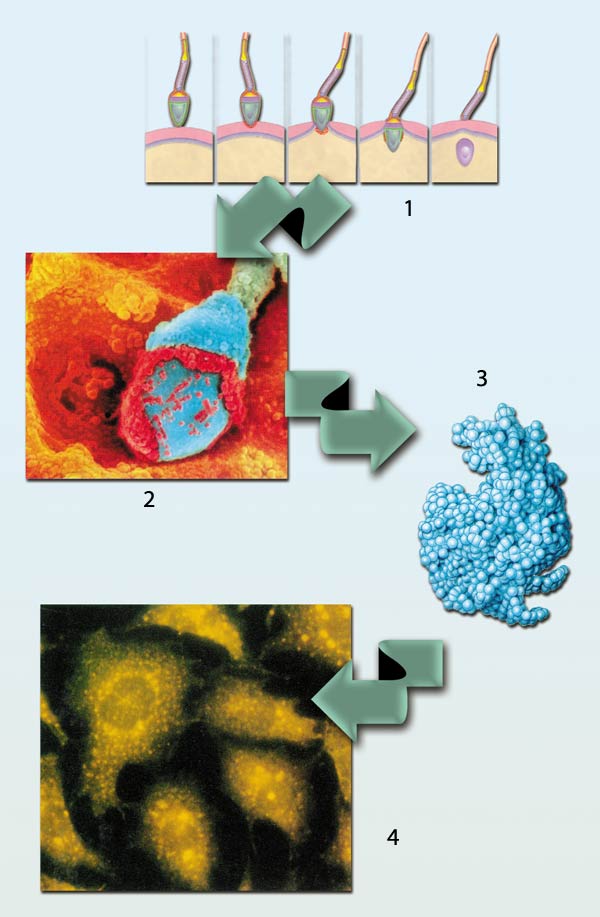 |
| 1. The sperm enters the egg by breaking through its outer membrane. |
From the moment you were born, you've been breathing with ease and, as a result, have been able to continue your existence. If you stop breathing for only a few minutes, this will lead to the cessation of all of your bodily functions and most possibly, to your death. Your very life depends upon a substance known as a surfactant, found in your lungs.
This substance envelops the roughly 300 million tiny air sacs, or alveoli, that let the lungs take in oxygen. Surfactant helps in the opening and closing of these sacs every time you breathe—no easy task.
One very important feature of this substance is that it starts being produced only one month before a person is born. And here begins the miraculous nature of this event.
How is it that a baby, who hasn't used its lungs while in its mother's womb, can foresee the difficulty of breathing when it comes out into the world—and then feel the need to start producing this substance? How does it know that the surfactant is able to help its alveoli? What type of chemical knowledge can it use to estimate its help in the movement of these sacs?
The absence of this substance—as in babies born prematurely—can lead to an infant's death in a very short time. But this seldom happens. For millions of years, every full-term newborn has emerged from the womb with lungs coated in this substance, enabling it to breathe with ease.
Undoubtedly this miraculous event is not realized through the will of the baby, nor through the intent of the mother. The One Who created this perfect system and Who allows it to be initiated at just the right time is God.
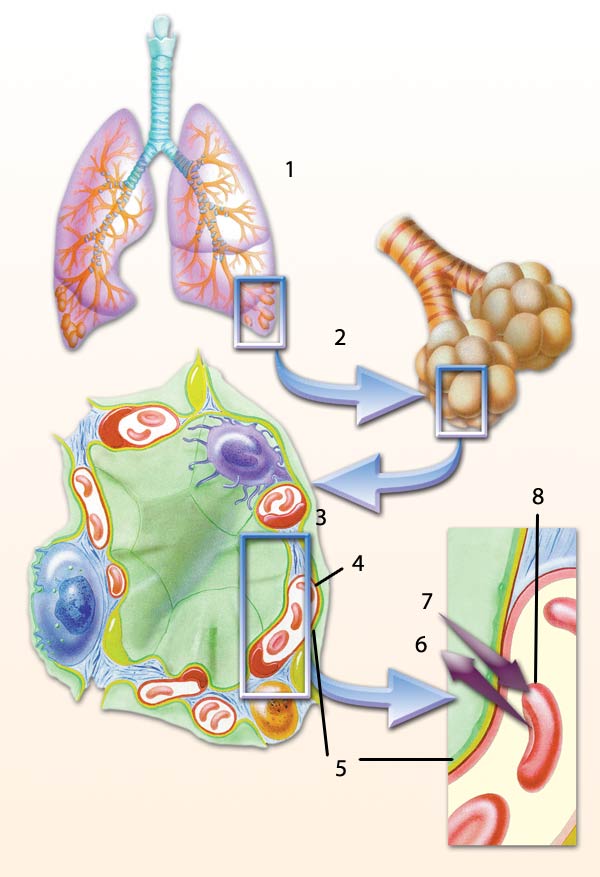 | |||
| 1. Lungs | 3. Cross section of an alveolus | 5. Surfactant layer | 7. O 2 |
| A substance called a surfactant facilitates the proper expansion of the alveoli, allowing them to fill with air every time we take a breath. | |||
| O man! What has deluded you in respect of your Noble Lord? He Who created you and formed you and proportioned you and assembled you in whatever way He willed. (Qur'an, 82: 6-8) | |||
The 100 trillion cells in our body work together in perfect harmony. To bring this about, the cells need to closely keep aware of one another's functions. For this purpose, they produce messenger molecules known as hormones. Thyroid hormone, for instance, controls the rate of metabolism in all cells. The insulin hormone regulates the amount of glucose in the blood and facilitates its entry into every cell in the body. Aldosterone stimulates the kidneys and so keeps the level of water and salt in the blood in balance. For the production of red blood cells, the message sent by the erythropoietin hormone is necessary.
Many hundreds of other hormones allow for the continuous communication among cells. Moreover, this takes place with the same perfection in every one of the billions of humans and animals on Earth. Without hormones, there would be no order in the body, only chaos and neglect.
But how can one cell know what another cell should be doing at a distance of centimeters away? How does it know what hormone will bring about the desired effect? And in addition, how does it know the structure of this hormone, or obtain the materials needed to make it in the first place?
The only logical answer is that everything in the body has been created with a certain plan of great knowledge and consciousness. The order found among the 100 trillion cells in every single person out of the billions on the face of the Earth is proof and wisdom of God's creation and His uniqueness.
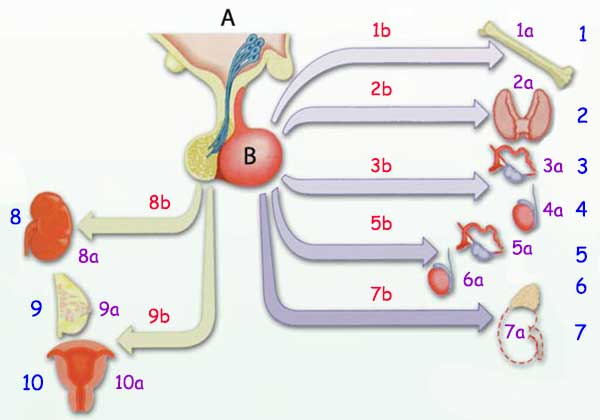 |
| A. Hypothalamus 1. Growth, 1a. bones, 1b. growth hormone |
| Hormones are molecules responsible for sending messages back and forth between cells. Thanks to these molecules, all of the body's processes can run flawlessly. Hormones control events we are not even aware of, from our blood pressure to our growth. |
| There is no god but He: That is the witness of Allah, His angels, and those endued with knowledge, standing firm on justice.There is no god but He, the Exalted in Power, the Wise. (Qur'an, 3:18) |
When the period of pregnancy is complete, the abrupt beginning of labor pains herald the start of a new life. A hormone called oxytocin initiates labor and sends the first indication of this impending event.
This hormone, released by the pituitary gland, has its effect in two main sites: on the muscles of the mother's uterus, and on the muscle cells that eject milk into the ducts of the breasts.
The increased contraction of the uterus is of utmost importance in ensuring that birth will take place safely for both mother and infant. This hormone facilitates the strong contractions of the muscles of the uterus—but does so only after nine months and ten days have passed since conception. Either earlier or later could put the baby's life in danger. When the right time comes, receptors in the uterus send signals to the brain. On receiving this signal the brain produces oxytocin, just the right molecule, and sends it to the target area—those receptors far away.
In addition to all this, oxytocin has another separate function, facilitating the nourishment of the baby just arrived to the world by secreting a supply of milk.
Consider:
How do cells in a tiny part of the mother's brain decide to produce a hormone that makes childbirth easy for the womb to perform?
How can this hormone find its way through the whole circulatory system, to the exact cells where it is needed?
Who possesses the knowledge that the baby needs to develop and mature for nine months and ten days in the mother's womb, and begins the mechanism of labor at just the right point?
Does the oxytocin hormone itself consider the baby's need to be fed and set up a system that ensures the secretion of milk from the mother?
Oxytocin is just one hormone out of thousands in our body. Just like it, every other hormone helps organize bodily functions; makes critical decisions; sets about implementing them; communicates with other cells; stimulates the needed secretions; determines the necessary amounts, the timing and duration—carrying out this and many other complex processes without fault.
Very obviously, such a wondrously perfect planning does not come about by itself, or as a result of coincidence. The Planner, Creator and Controller of the entire conscious organization of these hormones, down to the tiniest detail, is God, the Possessor of infinite knowledge.
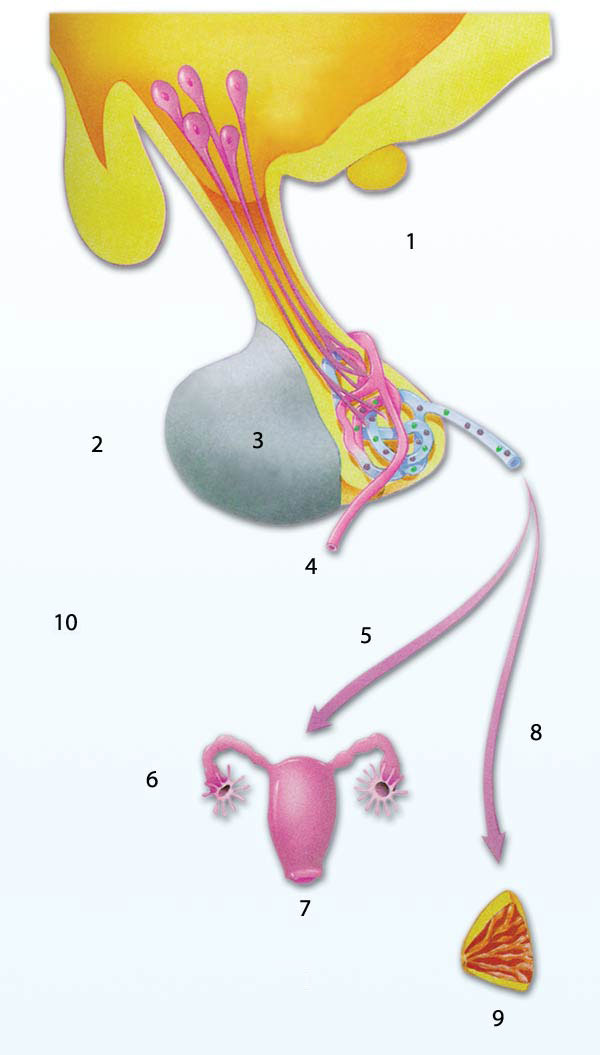 |
| 1. ADH and oxytocin hormones are released by the pituitary gland. |
Throughout the day, there are systems that detect the slightest changes to the amount of water in your body. The main one is an area, about the size of an almond, in the brain called the hypothalamus. Among other things, the hypothalamus is sensitive to the water content of the blood. When the water level drops, there is a noticeable, albeit small, decrease in blood pressure. At this point, baroreceptors come into play. Located at the aorta, where blood first exits the heart, they are involved with detecting changes in blood pressure. On being activated, these sensitive receptors immediately send a message to the hypothalamus, which in turn responds by ordering the pituitary, the pea-sized gland right beneath it, to begin producing and secreting a hormone called vasopressin, or ADH.
 |
| vasopressin hormone (ADH) |
Via the bloodstream, this hormone embarks on a long journey and eventually arrives at the kidneys. Just as a key fits into its intended lock, the kidney has special receptors that are just right for this hormone. When it reaches the receptors, they communicate the message that the kidneys need to go into water-saving mode, and the kidney cells immediately begin retaining water, to bring the amount of water lost to a minimum.
This same hormone also causes the sensation of thirst in the brain. And as a result of this perfect built-in system, of which we are totally unaware, we can balance our body's water level with a glass from the faucet.
If there were no pituitary hormone, or if kidney cells weren't able to understand and obey its command to retain water, we would need to drink between 15 and 20 liters of water a day in order not to die of thirst. And because we'd need to void this water continually, we wouldn't be able to sleep or stay in one spot for any length of time.
As we've seen, all parts of the system that balances our body's water level cooperate with the brain. Cells in the aorta notify the brain of the lack of water. Immediately realizing the consequences of this message, the brain then releases a signal that goes to the kidneys, the relevant organs out of all the others in the body, and tells them what to do.
These processes take place in our bodies countless times during the day, without our even being aware of them. Moreover, they take place in the bodies of all the people around us, and in all the people who have ever lived and will live in future. They all possess the same sensitive receptors. All their cells know how to respond to changes in blood pressure. The cells of every human being have been given this ability to measure changes in blood pressure.
How did such a complex and faultless system come about, appearing with the identical qualities in every single person?
That such a mechanism couldn't arise as a result of blind coincidence is clear to every person of intelligence. Also, it's not possible for this system's parts to have acquired these features on their own. Cells themselves cannot discover processes that even a human requires careful attention to read and understand. Moreover, vasopressin is only one of the hundreds of hormones found in the body. Each of the others has a similar relationship to its appropriate organ. And no hormone ever takes its message to the wrong place; every organ understands correctly and fully the message that the hormone carries. It's patently obvious that such a system was brought into existence by a superior Intelligence. The possessor of this intelligence is God, the Creator of everything.
Every human is responsible for reflecting upon these miracles of creation in their own bodies and for expressing gratitude to God, Who created them in such perfection.
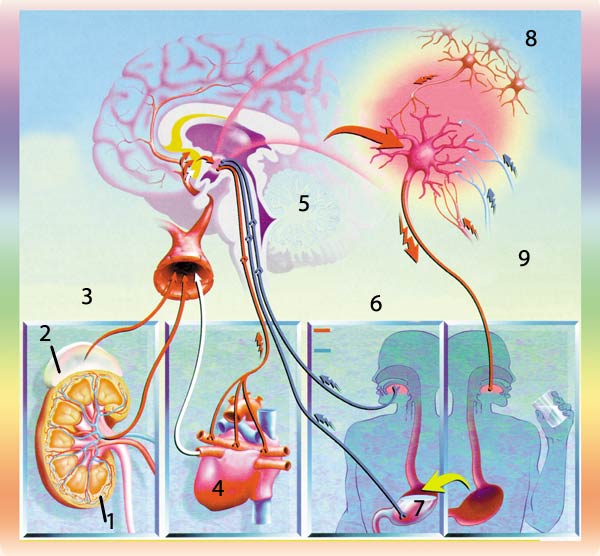 |
| 1. Kidney |
| O man! What has deluded you in respect of your Noble Lord? He Who created you and formed you and proportioned you and assembled you in whatever way He willed. (Qur'an, 82: 6-8) |
A great deal of harmonious cooperation exists between cells and hormones in the human body. The body recognizes hormones and immediately understands the message they carry. And the hormones know very well where they need to go and when, and the sort of effect they'll have. Even though the same hormones are present in both males and females, these hormones' effect on the two sexes is completely different. For example, the follicle-stimulating hormone known as FSH promotes the formation of the egg in the woman. Yet in males, the same hormone ensures the formation of the sperm.
On the other hand, luteinizing hormone (LH) stimulates ovulation and also causes the secretion of another hormone called progesterone, which prepares the uterus for pregnancy. The same hormone takes on a completely different role in males, stimulating cells to secrete testosterone, which facilitates the development of male secondary sexual characteristics and the formation of sperm.
How can two similar hormones with the same makeup lead to completely different effects in different genders? This question is definitely thought-provoking!
When the hormone is secreted in a male's body, it recognizes that the body cells here belong to a male and make changes accordingly. In a male body, for example, this hormone leads to greater muscular formation, to the deepening of the voice, and the formation of a beard.
In a woman, the exact same hormone is secreted, but its effect on her is practically the opposite. If the same hormone can give a feminine voice to a woman and a deeper one to a man, and can lead to the development of different bodily characteristics, then this hormone must be somehow "aware" of the differences in chemistry and anatomy between the man and woman. In turn, this means that the hormone must possess a mind and have received training in these subjects.
How can these hormones have acquired chemical knowledge? Or how is it that the cells producing these hormones understand not only the chemistry of the human body but also, like practicing chemists, can secrete from themselves substances in accord with this knowledge and direct other cells into production as well? How did tiny cells acquire the knowledge to do all this?
Clearly, this knowledge is not a property of the cells or the atoms that compose them. These regulations, made peculiar to men and women, are a sign of an existing conscious plan and design. What lies behind this conception is a Possessor of superior intelligence—that is, God.
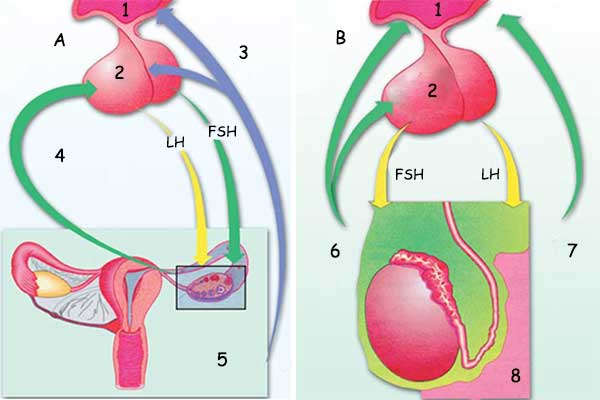 | |
| A. Hormonal Regulation in Women 1. Hypothalamus | 4. LH stimulates ovulatio and the secretion of progesterone. 7. LH secreted by the pituitary gland promotes the secretion of testosterone. 8. Sperm production is promoted.
|
The human body's 100 trillion cells carry out their duties faultlessly thanks to the thyroid hormones.
The more thyroid hormone in the blood, the faster the cells will work. If the body does not secrete enough thyroid, metabolism slows down considerably and virtually comes to a stop. For this reason, there must be a certain level of thyroid hormone in the blood at all times.
It's impossible for the thyroid gland to take up the duty of affecting other cells and to make such decisions on its own. It is unaware of other cells' existence. It only obeys to the letter the commands present in the DNA of its own cells.
The power that gives these written commands to the thyroid gland and brings them about is God, the One Who created every tiny detail. The plan, design and consciousness at work here does not belong to an unconscious piece of flesh, a gland unaware of its own existence that goes by the name of "thyroid." It belongs to God.
Evolutionists, however, in denial of this, claim that:
- the thyroid gland "feels the need" to stimulate all of the body's cells, and therefore has designed hormones that would affect all cells;
- it has perfectly produced these hormones all by itself, and
- decides by itself the level of hormone that needs to be in the blood at all times.
This is nothing but conjecture, of course. It's in no way possible for an endocrine gland to have the knowledge to think of any of this, or to bring it all about. The Creator of everything in harmony with everything, and the One Who made things to be interdependent, is the One with knowledge of all things—that is, God.
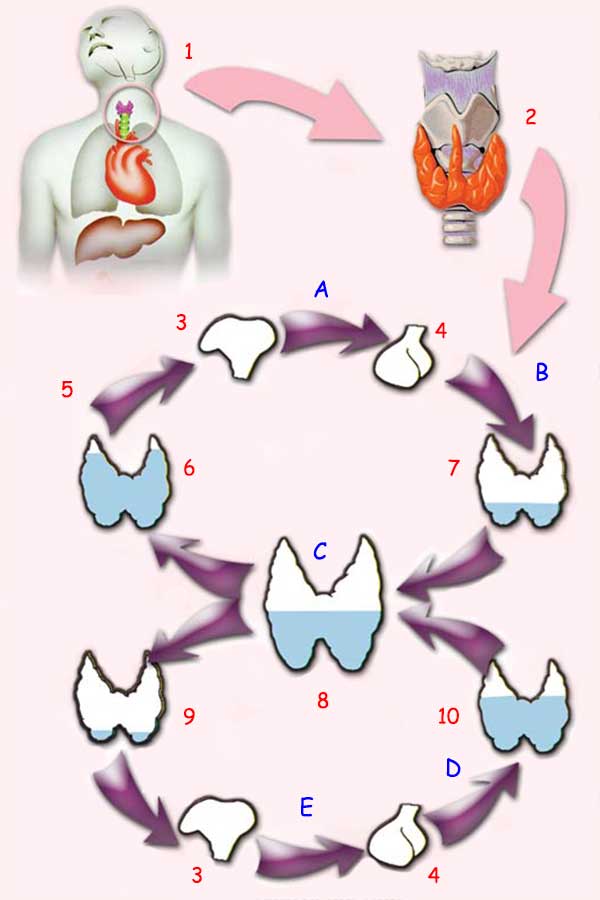 | ||
| A. FACTOR THAT PROMOTES LOW SECRETION | 1. thyroid gland | 6. overworked |
| The diagram above summarizes the effect of thyroid hormone level on the body's metabolism. | ||
Insulin is yet another hormone that humans cannot live without. In cases where not enough of this hormone is secreted, blood sugar levels rise and cannot be balanced. This can lead to a person falling into a glucose (or diabetic) coma. Insulin, so crucial to the human body, is a protein made up of 51 amino acids. The diagram below shows the order of amino acids (shown in the circles) found in insulin. Should there be the slightest mistake in this order of amino acids, the insulin will not be able to perform its duty.
If a person reads a formula written on paper, he or she would know that it could not have appeared by itself, that someone must have written it down. The insulin hormone does have a certain formula. Moreover, in every human who ever lived, insulin has been produced according to this formula. This is enough to prove that insulin could not have come about over time, through coincidence. No unconscious coincidence could have resulted in the same formula being produced in billions of people, not to mention animals. Such a claim goes against all reason, all intelligence, all science.
The Creator of insulin, the Determiner of the features it would possess, is the One Who created insulin when mankind first came into being—that is, God.
 |
| 1. Insulin hormone |
 | |
| 1. High |
By themselves, the kidneys measure the number of red blood cells being pumped to them. Information determined by sensitive receptors is immediately evaluated, and measures taken accordingly.
When the kidneys determine a decrease in the red blood cell count, special kidney cells secrete a hormone called erythropoietin, which helps increase blood production. The hormone has its effect outside the kidneys, in the main blood production cells in the bone marrow. When this hormone communicates that the level of erythrocytes is low, the bone marrow facilitates the rate of production and release of erythrocytes into the bloodstream. This way, the quantity of red blood cells is kept in proper balance.
In short, the kidneys can make a number of measurements, evaluate information, and take initiative to apply the necessary precautions. And the hormone that has the duty of transmitting the message can travel through the body without getting lost, reaching the bone marrow without any problem or delay. Bone marrow cells also know how to decode the message the hormone sends them from the kidneys, and act according to this message.
Moreover, all these processes take place in every one of billions of people. In all of them, this cooperation proceeds in exactly the same way.
Throughout all of these processes, the cells display an evident intelligence and act as the disciplined and obedient components of a faultless organization. This situation begs the question of what the source of this intelligence and cooperation can be. No one can claim that cells possess this intelligence of themselves, or by happenstance. The One Who has inspired these cells with this intelligence and knowledge about how to act is God, Who maintains control over all things.
There is no power or might except God.